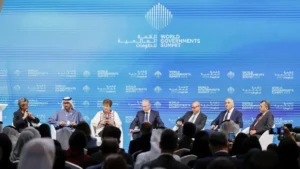Solar Club Builds Up a Powerful Alliance
Indian and French leaders fulfill pledges made at the Paris climate talks to help 122 solar-rich nations reach their potential in renewable energy production. The sun rises on a solar thermal power plant in Rajasthan, India. (India One via Wikimedia Commons)
The sun rises on a solar thermal power plant in Rajasthan, India. (India One via Wikimedia Commons)
By Nivedita Khandekar / Climate News NetworkThis Creative Commons-licensed piece first appeared at Climate News Network.
New Delhi –The foundation stone of a new solar power club of 122 nations has been laid in Gurgaon, India, by the Indian Prime Minister, Narendra Modi, and the French President, François Hollande — cementing an agreement the two leaders made at the Paris climate talks last December.
The idea of the International Solar Alliance (ISA), which promises a massive increase in investment in solar power in the tropics, started with the coming together of countries between the Tropic of Cancer and Tropic of Capricorn that have 300-plus days of sunshine a year.
For all of them, solar power is potentially the cheapest form of generating electricity. And the plan is to provide electricity to millions of people who do not have access to power at present, while at the same time preventing the building of dozens of power plants that burn fossil fuels.
Foundation stone
The ISA will be an inter-governmental body on the lines of the UN, with headquarters in India. This building will be on a five-acre plot of land at the National Institute of Solar Energy campus at Gurgaon, Haryana.
At the laying of the foundation stone, the two heads of state — President Hollande was in New Delhi as the chief guest for India’s Republic Day Parade yesterday — reiterated their commitment to the development of solar energy.
Modi has already proved to be a solar enthusiast, with more than 5,000 megawatts of installed capacity in India — the equivalent of five of the largest type of coal-fired plants.
He says: “If fossil fuel is used, it adds to global warming. If not used, the world would plunge into darkness. But the entire world says we need to reduce the temperature. The need is for alternative, sustainable and affordable energy.
“One of the ways to reduce temperature here is to use the sun’s temperature. We need to use one form of energy to fight the negative effects of another form of energy.”
Hollande praised the idea of the Alliance, which he described as “India’s gift to the world for combating climate change”. He said it “came from a country where, for millennia, yoga practitioners have greeted the sun every morning so that it shares its energy with the Earth.
“The challenge now is to raise at a global level the €1,200 billion in investment required to develop this energy by 2030. The aim is for 1,000 gigawatts to be installed over the next 10 years.”
“India’s electricity will grow
threefold by 2030, but its non-fossil electricity sources
will grow fourfold.”
Hollande also listed the expectations from the Solar Alliance: pooling the demand for high potential countries to bring down financial costs; harmonising and opening up the solar markets to reduce the cost of investment; and, most important, enabling the necessary technology transfer between developed and developing countries.
The Indian Renewable Energy Development Agency and the Solar Energy Corporation of India each announced a $1 million donation to finance the new ISA headquarters and towards its running costs for five years.
Over the same period, the French Development Agency will allocate €300 million to developing solar energy in order to finance the initial projects.
Emission intensity
Continuing development of solar is important for India, which has 17% of the world population and is the third largest polluter, after the US and China.
India’s climate plan, published last year, promised to reduce the emission intensity of the country’s gross domestic product by 33%-35 % by 2030 from 2005 levels. It is aiming at 40% cumulative power from renewables by 2030, including a target of 100 GW of solar energy by 2022.
So how are these developments and plans expected to change India’s energy mix?
Dr Arunabha Ghosh, chief executive officer of the Council on Energy, Environment and Water, explains: “India’s electricity will grow threefold by 2030, but its non-fossil electricity sources will grow fourfold.
“This means that there will be proportionately faster deployment of non-fossil (including solar) energy than coal or gas-based power. This transformation will be reflected in reduced emissions (against business as usual scenarios) and reduced emissions intensity of GDP.”
Nivedita Khandekar is a Delhi-based independent journalist who writes on environmental, developmental and climate change issues. Email: [email protected]; Twitter: @nivedita_Him.
Your support matters…Independent journalism is under threat and overshadowed by heavily funded mainstream media.
You can help level the playing field. Become a member.
Your tax-deductible contribution keeps us digging beneath the headlines to give you thought-provoking, investigative reporting and analysis that unearths what's really happening- without compromise.
Give today to support our courageous, independent journalists.






You need to be a supporter to comment.
There are currently no responses to this article.
Be the first to respond.